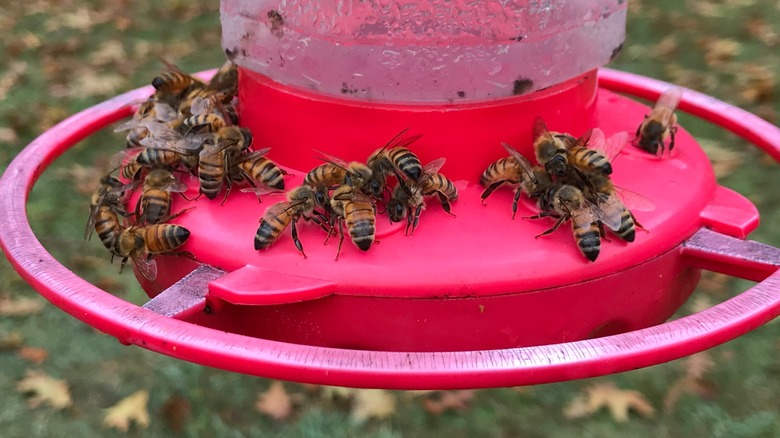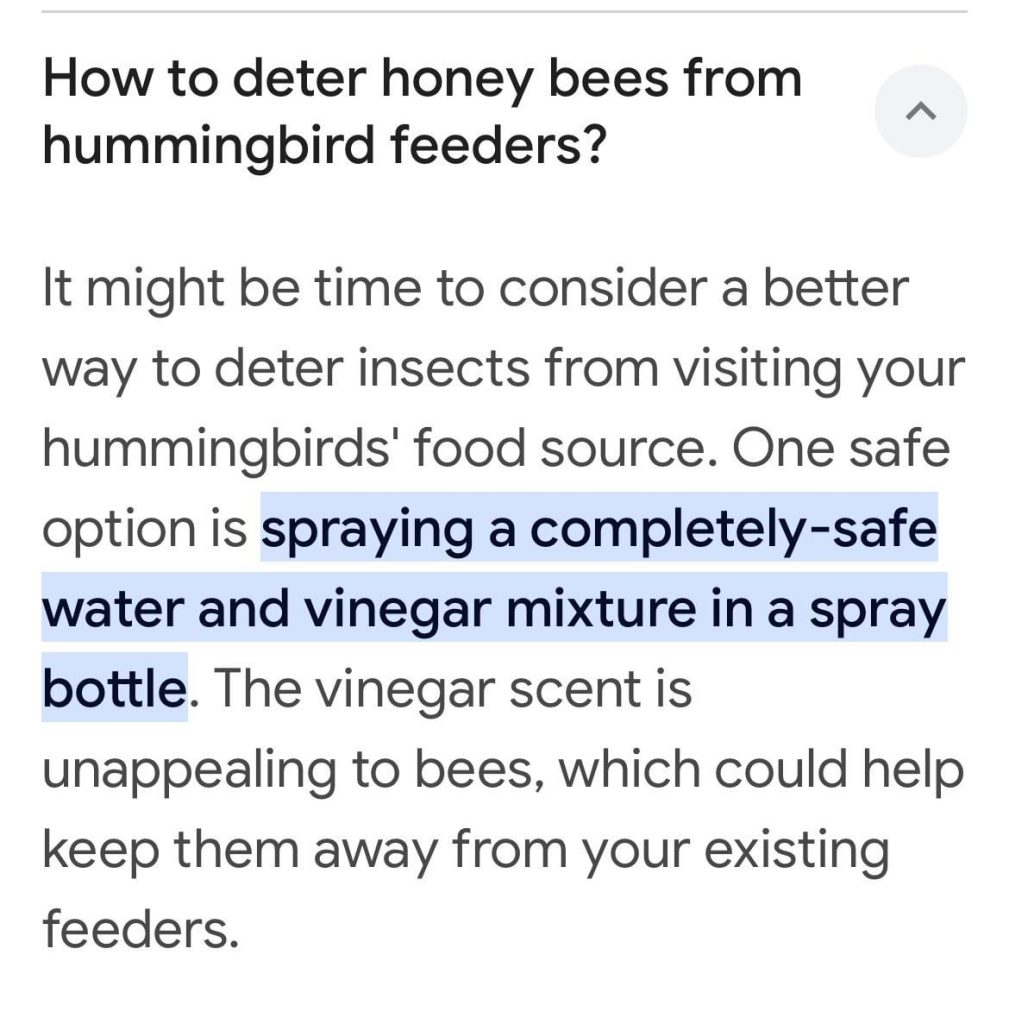Have you ever set up a hummingbird feeder in your garden only to find it swarmed by bees instead? It’s frustrating, isn’t it?
You want to provide a sweet oasis for your feathered friends, but the bees have other plans. Not only can bees chase away the hummingbirds, but they can also make it difficult for you to enjoy your outdoor space. Don’t worry, though—there are simple strategies you can use to keep those bees at bay and ensure your hummingbird feeder serves its intended guests.
Let’s dive into some effective solutions that will help you reclaim your feeder and enjoy the delightful company of hummingbirds without the buzzing distractions. Curious about how you can achieve this? Keep reading to discover practical tips that can transform your backyard into a bee-free paradise for hummingbirds.
Why Bees Visit Hummingbird Feeders
Hummingbird feeders attract more than just hummingbirds. Bees often visit these feeders, drawn by the sweet nectar inside. Understanding why bees come helps in preventing them from taking over the feeder. This knowledge guides better feeder choices and placement.
Attraction To Nectar
Bees seek sugar for energy. The nectar in hummingbird feeders is a perfect food source. It contains a high concentration of sugar that bees find irresistible. The bright red color of many feeders also signals a food source to bees. They quickly learn to associate the color with nectar.
Feeder Design Factors
The design of the feeder affects bee visits. Large feeding ports allow easy access for bees. Shallow or wide openings make it simple for them to reach the nectar. Some feeders lack bee guards, making it easier for bees to enter. Materials and colors also play a role. Plastic feeders with red parts attract more bees than glass ones with less color.

Credit: www.hummingbirdsociety.org
Choosing Bee-resistant Feeders
Choosing the right feeder helps keep bees away from your hummingbird feeder. Some feeders are designed to stop bees from reaching the nectar. These feeders make it easy for hummingbirds to feed but hard for bees.
Bee-resistant feeders reduce the chance of bee visits. They protect the nectar with special features. This lets hummingbirds enjoy the food without sharing it with bees.
Bee Guards And Screens
Bee guards are small plastic or metal barriers. They cover the feeding ports to block bees. Hummingbirds can still reach the nectar through tiny openings. The openings are just big enough for their beaks.
Screens work like bee guards but cover larger areas. They stop bees from landing on the feeder. This reduces the chance of bees finding the nectar.
- Look for feeders with built-in bee guards.
- Choose feeders with small feeding holes.
- Use screens to cover exposed nectar areas.
Feeder Placement Tips
Place the feeder where bees are less active. Bees like warm, sunny spots near flowers. Put the feeder in shaded or breezy areas. This helps keep bees away but hummingbirds stay comfortable.
Keep feeders away from bee nests or hives. Move feeders if bees keep coming back. Use a hook or pole to hang the feeder higher. Hummingbirds can reach it, but bees find it hard to access.
- Place feeders in cool, shaded locations.
- Hang feeders away from flowering plants.
- Adjust feeder height to limit bee access.
Using Bee Deterrents Safely
Using bee deterrents safely is crucial to keep your hummingbird feeder bee-free without causing harm to the tiny birds you want to attract. It’s easy to get frustrated when bees swarm your feeder, but aggressive measures can backfire and scare off hummingbirds or even hurt the environment. You need solutions that protect your feeder while respecting all creatures involved.
Natural Repellents
Natural repellents offer a gentle way to discourage bees without toxic chemicals. Try placing a small dish of water with a few drops of peppermint or clove oil near your feeder—bees dislike these scents, but hummingbirds don’t mind them.
Another trick is sprinkling cinnamon or ground cayenne pepper around the feeder base. These spices repel bees but are safe for hummingbirds and other wildlife.
Have you noticed that bees avoid certain plants? Planting bee-repelling herbs like basil or mint near your feeder can help as well. These natural methods create a barrier without harming anyone.
Avoiding Harm To Hummingbirds
It’s important to remember that some repellents can irritate hummingbirds’ sensitive eyes and respiratory systems. Avoid sprays or powders directly on the feeder’s feeding ports.
Use feeders designed with bee guards or those with smaller feeding holes that bees can’t access but hummingbirds can easily use. This physical barrier is often the safest option.
Check your feeder regularly for leftover sugary residue, as it attracts bees and can cause mold harmful to hummingbirds. Cleaning your feeder often ensures a healthy environment for your feathered visitors.
Have you ever seen a hummingbird struggle at a feeder crowded with bees? That’s a sign to rethink your approach and focus on gentle deterrents rather than harsh chemicals or traps.

Credit: www.housedigest.com
Maintaining Clean Feeders
Keeping your hummingbird feeder clean plays a key role in preventing bees from invading it. Dirty feeders attract insects, including bees, because of old, sticky nectar. Clean feeders provide fresh nectar only for hummingbirds, making the feeder less appealing to other insects.
Regular cleaning also helps stop mold and harmful bacteria. These can harm hummingbirds and make the feeder unusable. A clean feeder supports healthy feeding habits and keeps bees away naturally.
Regular Cleaning Schedule
Wash your feeder every three days during warm weather. In cooler months, clean it once a week. Use hot water and mild soap to remove sugar residue and mold. Avoid harsh chemicals that can hurt birds.
Rinse the feeder thoroughly to remove all soap. Let it dry completely before refilling with fresh nectar. This routine stops nectar from spoiling and keeps bees from smelling old sugar.
Proper Sugar Water Preparation
Make fresh sugar water using one part white sugar to four parts water. Boil the water first to kill any bacteria. Stir until the sugar dissolves completely.
Do not add honey, artificial sweeteners, or red food coloring. These attract bees and can harm hummingbirds. Always cool the sugar water before filling your feeder.
Alternative Feeding Stations
Creating alternative feeding stations helps keep bees away from your hummingbird feeder. Bees have their own food sources, so providing separate options can reduce their interest in the hummingbird nectar. This approach supports both bees and hummingbirds in your garden.
Separate Bee Feeders
Place feeders with sugar water or diluted honey away from hummingbird feeders. Use shallow dishes or specialized bee feeders to attract bees. This keeps bees busy and less likely to visit hummingbird feeders. Position these feeders in shaded, quiet spots to encourage bee visits.
Planting Bee-friendly Flowers
Grow flowers that attract bees near your home or garden. Choose native plants rich in nectar and pollen. Examples include lavender, coneflowers, and sunflowers. These flowers provide natural food sources and distract bees from hummingbird feeders. This also creates a healthy environment for pollinators.

Credit: www.countryliving.com
Frequently Asked Questions
How Can I Stop Bees From Visiting My Hummingbird Feeder?
Use bee-proof hummingbird feeders with smaller feeding ports. Place feeders in shaded areas to reduce nectar fermentation, which attracts bees. Regularly clean feeders to avoid sticky residue. Adding bee guards or using feeders with bee-resistant design also helps keep bees away effectively.
Why Do Bees Go To Hummingbird Feeders?
Bees are attracted to the sweet nectar in hummingbird feeders. The sugar solution mimics flower nectar, making feeders a food source. They seek energy-rich nectar, especially when natural flowers are scarce. This causes them to swarm around feeders if not properly protected.
What Is The Best Nectar Recipe To Prevent Bees?
Use a simple nectar mix of four parts water to one part white sugar. Avoid using honey or artificial sweeteners as they attract more insects. Boil the water to dissolve sugar fully and cool before filling feeders to keep nectar fresh and less attractive to bees.
Can Placing Feeders Away From Flowers Reduce Bee Visits?
Yes, placing feeders away from flowering plants can reduce bee traffic. Bees prefer natural flowers over feeders, so distancing feeders limits their attraction. Position feeders in open areas, away from gardens or flower beds, to minimize bee competition and protect hummingbird feeding spots.
Conclusion
Preventing bees from visiting your hummingbird feeder takes small, smart steps. Use bee guards or move feeders to shady spots. Clean feeders often to avoid attracting bees. Choose feeders with bee-resistant designs. Watching hummingbirds without bee trouble is possible. Keep trying different methods until you find what works best.
Enjoy the bright colors and sweet visits from hummingbirds. Your patience will pay off with peaceful, bee-free feeding. Simple actions make a big difference for your backyard friends.

